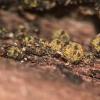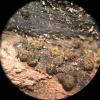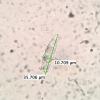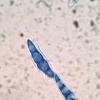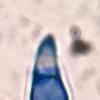
09-12-2025 12:06
 Andgelo Mombert
Andgelo Mombert
Bonjour,Je recherche l'article concernant Hypobryo

12-12-2025 18:39
Mirek GrycHello everyone.Macrofeatures similar to Mollisia b

07-12-2025 16:07
Arnold BüschlenHallo, ich habe in einer Moos-Aufsammlung (epiphy

08-12-2025 21:04
Mark Stevens"Hello everyone,I'm relatively new to microscopy (

08-12-2025 18:59
 Lothar Krieglsteiner
Lothar Krieglsteiner
.. found by a seminar-participant, I do not know t

08-12-2025 17:37
 Lothar Krieglsteiner
Lothar Krieglsteiner
20.6.25, on branch of Abies infected and thickened
Bitunicate pyrenomycete with yellow-green colors
Ethan Crenson,
07-11-2021 22:17
Hello all,
I'm trying to identify a bitunicate pyrenomycete. I found it yesterday on growing on the surface of well-rotted hardwood. It may have been associated with a Hypoxylon that was also on the substrate. Fruiting bodies are hard and carbonaceous, spherical, less than 1mm in diameter and covered in a yellow-green powdery substance.
Asci are bitunicate, 110 x 13µm.
Spores are hyaline, 1-septate with 4 oil droplets and the constriction at the septa that creates a characteristic shape that I associate with Diaporthe-like species (am I right about that?). The spores also appear to have a sheath of some sort that covers most of the spore. They measure 34.5-37.9 x 7.9-10.7 (measured without the sheath).
Does anyone recognize this pyreno?
Thanks in advance,
Ethan
Jacques Fournier,
08-11-2021 09:55

Re : Bitunicate pyrenomycete with yellow-green colors
Hi Ethan,
this sounds like Pseudotrichia mutabilis (Persoon: Fr.) Wehmeyer. Not sure it has not been combined under a new name.
Good luck,
Jacques
Ethan Crenson,
08-11-2021 14:52
Re : Bitunicate pyrenomycete with yellow-green colors
Jacques,
Thank you! That is definitely my pyreno! I was looking in the database in the Diaporthaceae, clearly that was wrong. But I'd never have imagined that the root "trichia" would be involved in any way.
Thanks again!
Ethan
Jacques Fournier,
08-11-2021 15:11

Re : Bitunicate pyrenomycete with yellow-green colors
Ethan,
this highlights the importance of assessing first whether a pyreno is uni-or bitunicate before getting to a family or a genus.
This key character is not always easy to observe and requires careful observations. It is more obvious in immature asci and using stains like chlorazol black is often helpful.
Cheers,
Jacques
